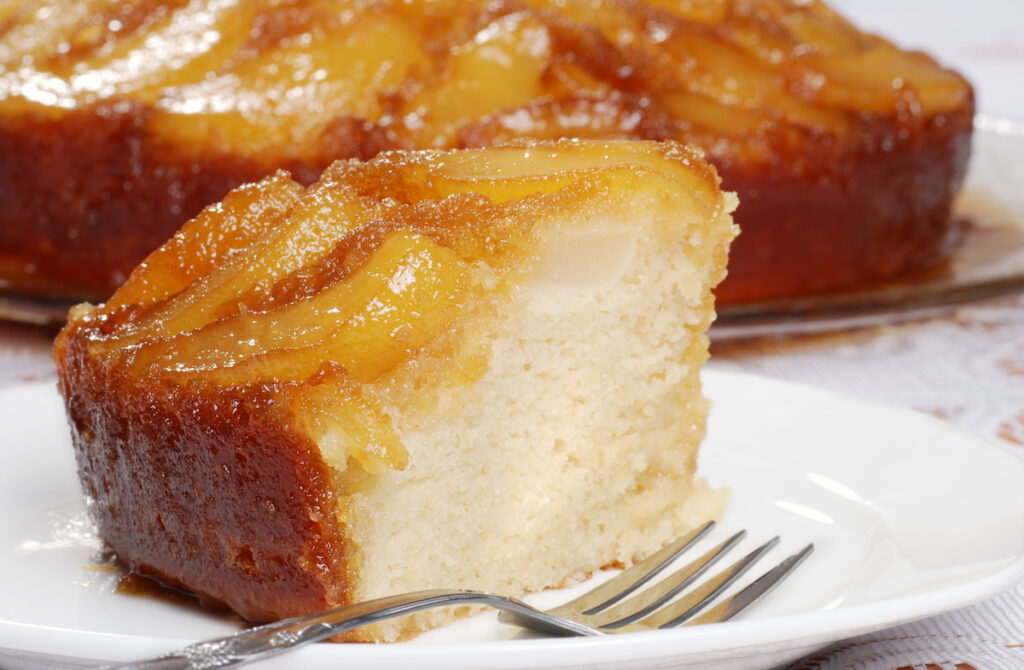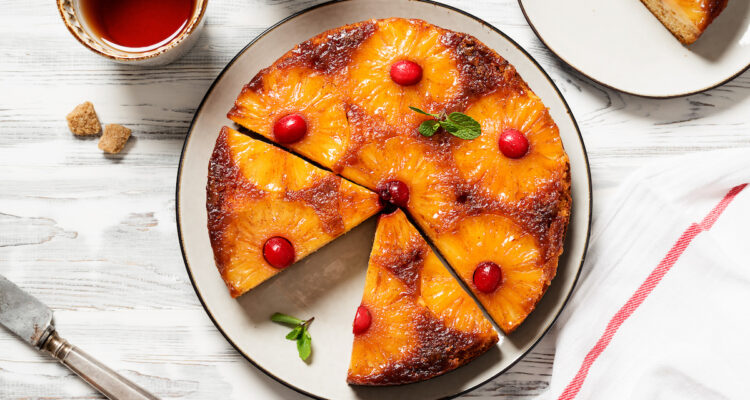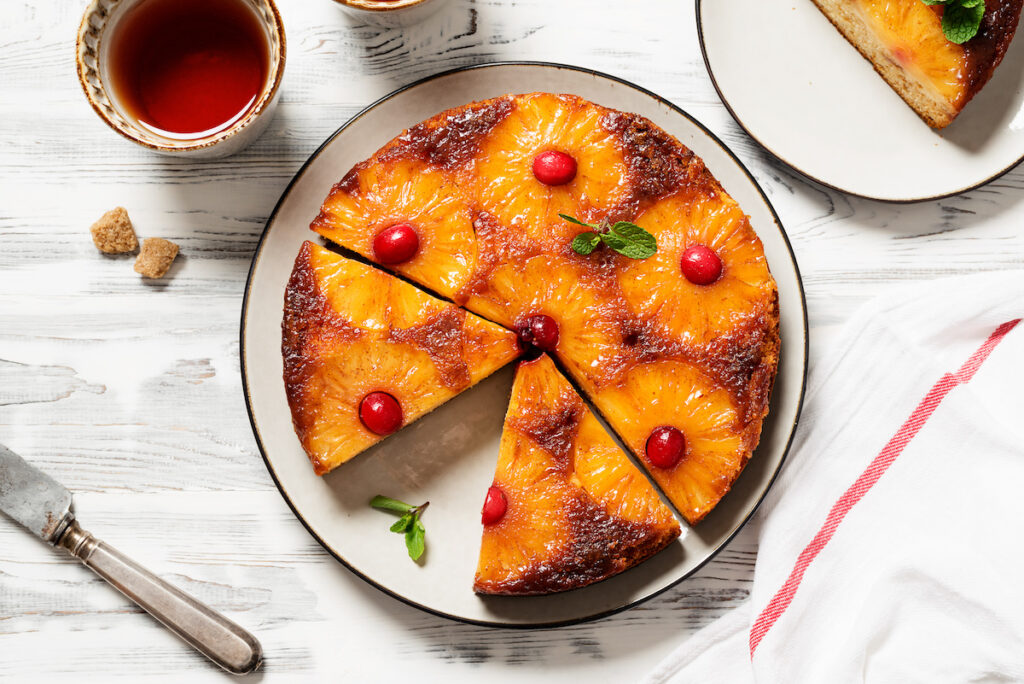
Upside down cakes have always intrigued me with their unique preparation and presentation. The concept of baking a cake “upside-down” and then flipping it over to reveal a beautiful, fruit-topped creation never fails to impress. Originating from the practice of cooking in a skillet, upside down cakes have evolved over time, with the ever-popular pineapple version paving the way for numerous other delicious fruit combinations.
In order to understand the history and appeal of these cakes, I explored various sources and unearthed a fascinating story that dates back to the early 20th century, when one of the first recipes was published in the now-defunct Syracuse Herald. Armed with newfound knowledge and appreciation, I began experimenting with recipes, techniques, and various fruit selections to create a comprehensive guide to upside down cakes, including step-by-step instructions, helpful tips, and, of course, a list of 10 unique and mouthwatering variations to inspire your own baking adventures.
What is Upside Down Cake?
Upside down cake is a delightful dessert where fruit, caramelized sugar, and cake batter are artfully combined to create a visually stunning and delicious treat. The cake is aptly named for its unique baking technique, which involves layering the ingredients in a reverse order, and then flipping the baked cake onto a serving plate. This results in a beautiful fruit and caramel glaze on top of the soft, tender cake.
I discovered that the origins of the upside down cake can be traced back to the simple practice of cooking fruit in sugar and butter in a cast-iron skillet. The cake has evolved over time, with the most popular version being the pineapple upside-down cake, which gained widespread popularity in the United States in the 20th century.
The basic recipe for an upside down cake involves melting butter and brown sugar in a pan, arranging sliced fruit on top, and then pouring the cake batter over the brown sugar glaze and fruit before baking. Once cooked, the cake is carefully flipped onto a serving plate, revealing the beautifully caramelized fruit topping [Delishably].
In the following sections, I’ll share the history of upside down cake, step-by-step instructions for making your own, some useful tips, and ten delightful variations to try. Stay tuned!
History
Upside down cakes have a rich historical background, and their innovation is rooted in the way our ancestors used to cook cakes and breads over open fires. The origins of upside down cakes can be traced back to the times when people began cooking in skillet pans over fires, and incorporated fruit and sugar to caramelize at the bottom of the pan, topped with a simple cake batter (The Simple Things) .
The evolution of the upside down cake is linked to the development of cake pans. Skillet cakes, the precursors of modern-day cakes, were made possible with the advent of cooking in cast-iron pans (The Nibble). As cake baking progressed, the concept of cooking fruit at the bottom of the pan and then flipping it to be served fruit-side up became popular.
One of the most iconic upside down cakes, the pineapple upside down cake, gained massive popularity in the 20th century, thanks to the introduction of canned pineapple by the Dole company. The convenience of canned pineapple, along with the classic technique of baking cakes in skillets, led to the widespread enjoyment of this delightful dessert (Quaint Cooking).
In today’s world, the upside down cake is a dessert favorite for its unique combination of caramelized fruit and fluffy cake, offering a delicious contrast in flavors and textures. This classic baking technique has given rise to numerous variations, each celebrating the versatility of upside-down cakes (Merriam-Webster).
Basic Recipe
Upside down cake is a delightful dessert with a fruit layer on the bottom and cake on top. When flipped, the fruit layer becomes a gorgeous topping, making it a visually appealing and delicious treat. Let me share with you my basic recipe that you can use as a starting point to create various versions.
Ingredients
- 1/4 cup (1/2 stick) unsalted butter
- 2/3 cup light brown sugar, tightly packed
- 1 1/3 cups all-purpose flour
- 1 1/2 teaspoons baking powder
- 1/2 teaspoon salt
- 1/3 cup shortening or softened butter
- 1 cup granulated sugar
- 1 large egg
- 3/4 cup milk or sour cream
- Fruit, enough to cover the bottom of the pan (e.g., pineapple slices, cherries, peach slices, or other fruit of your choice)
You may need to adjust the fruit quantity depending on the type and size of the fruit you use.
Instructions
- Preheat your oven to 350 °F (175 °C). Grease a 9-inch round baking pan with softened butter.
- In a small saucepan, melt the butter, and then add the brown sugar. Stir until the sugar has dissolved and the mixture is smooth. Pour this mixture into the prepared pan and spread it evenly across the bottom. Arrange the fruit on top of the sugar mixture in a pattern of your choice.
- In a medium bowl, whisk together the flour, baking powder, and salt. Set aside.
- In a large bowl, cream together the shortening (or butter) and granulated sugar until light and fluffy.
- Beat in the egg.
- Gradually add the flour mixture to the sugar mixture, alternating with the milk (or sour cream), starting and ending with the flour mixture. Mix until just combined.
- Pour the cake batter carefully over the fruit layer in the pan, spreading it evenly to the edges.
- Bake for 40—45 minutes or until a toothpick inserted into the center of the cake comes out clean.
- Let the cake cool in the pan for about 10 minutes, then carefully flip it onto a cake plate. Allow it to cool completely before serving. You can also serve the cake warm.
Now that you have this basic cake recipe, feel free to experiment with different fruit combinations and variations by adding spices, nuts, or herbs. Remember to have fun and enjoy baking!
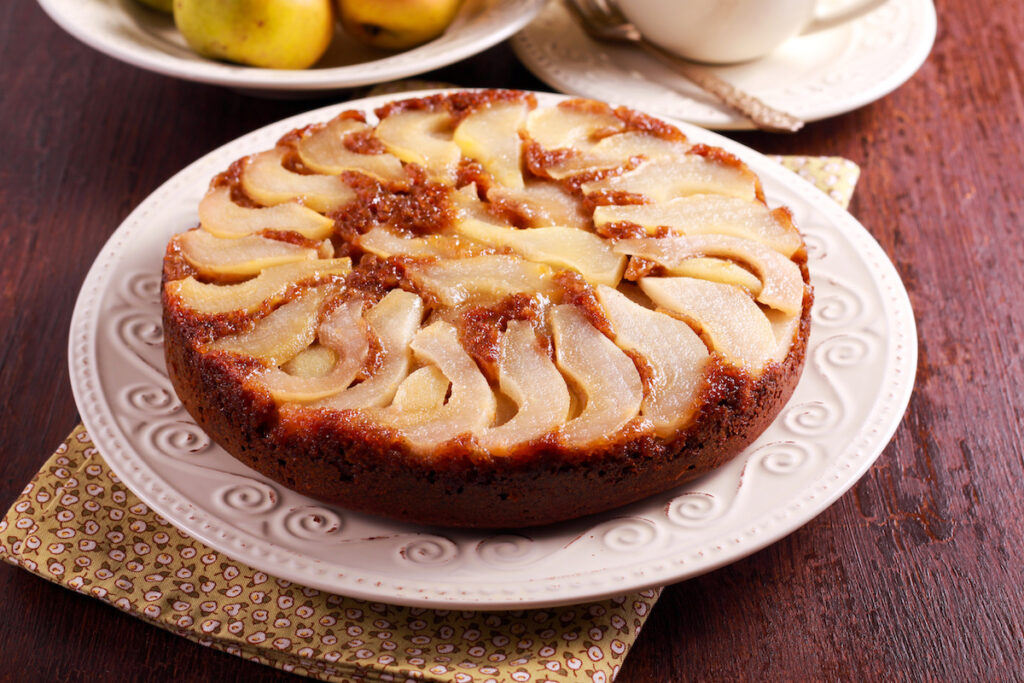
Baking Tips
When it comes to making a perfect upside down cake, I have gathered some essential baking tips to help you achieve a delicious and flawless result. Paying attention to these tips will ensure that your cake comes out moist, evenly baked, and with an irresistible caramelized layer.
First, always begin by greasing the cake pan well, using either butter or a non-stick spray. This is crucial for making sure the cake won’t stick to the pan when you invert it onto a serving plate later. Once your cake pan is ready, melt some butter and mix it with sugar and your chosen fruit. The fruit, butter, and sugar combination creates a fantastic caramel layer that will form the top of the cake.
Next, I recommend evenly arranging the fruit slices in the bottom of the pan before pouring the cake batter on top. This not only makes the cake visually appealing but also helps the fruit bake more uniformly.
Baking the cake at the right temperature is essential for a moist and tender crumb. Most upside-down cakes bake best at around 350 °F (175 °C), but always refer to the specific instructions of your recipe. Make sure you test the cake for doneness before removing it from the oven, using a toothpick or skewer to ensure the center is fully cooked.
Once your cake is done baking, it is essential to let it cool for about 5—10 minutes on a wire rack before attempting to flip it onto a serving plate. As suggested by Taste of Home, run a knife along the edge of the pan to loosen up the cake, then invert your serving plate over the pan and flip it quickly. Let the cake rest on the plate for a few minutes, allowing gravity to ensure it releases in one piece.
For an elegant touch, add fresh herbs or even edible flowers to the topping. Alternatively, serve vanilla ice cream or whipped cream with the cake.
10 Variations of Upside Down Cake
Now that you’ve learned some key baking tips for making a flawless upside-down cake, explore the following ten variations to delight your friends and family:
- Pineapple
- Apple Cinnamon
- Berry
- Peach
- Banana
- Cherry
- Pear Ginger
- Mango
- Lemon Blueberry
- Caramel Nut
Pineapple Upside Down Cake
I personally love the classic Pineapple Upside Down Cake, which includes pineapple slices and maraschino cherries, arranged at the bottom of the cake pan, topped with a buttery, brown sugar topping. Bake the cake according to the recipe instructions, and the beauty of the pineapple fruit design will be revealed when inverted.
Apple Cinnamon Upside Down Cake
For fall flavors, I recommend trying an Apple Cinnamon Upside Down Cake. Start with a layer of thinly sliced apples, cinnamon, and brown sugar. Combine this mixture with an apple pie spiced cake batter, and follow the baking instructions. This cake is perfect for pairing with a cup of hot apple cider.
Berry Upside Down Cake
For those who love berries, a Berry Upside Down Cake is a great option. Combine your favorite berries such as raspberries, blueberries, and blackberries with some sugar and lemon juice, arranging them at the bottom of the pan. A simple vanilla cake batter accompanies the berries, and the final cake is a colorful and fruity delight.
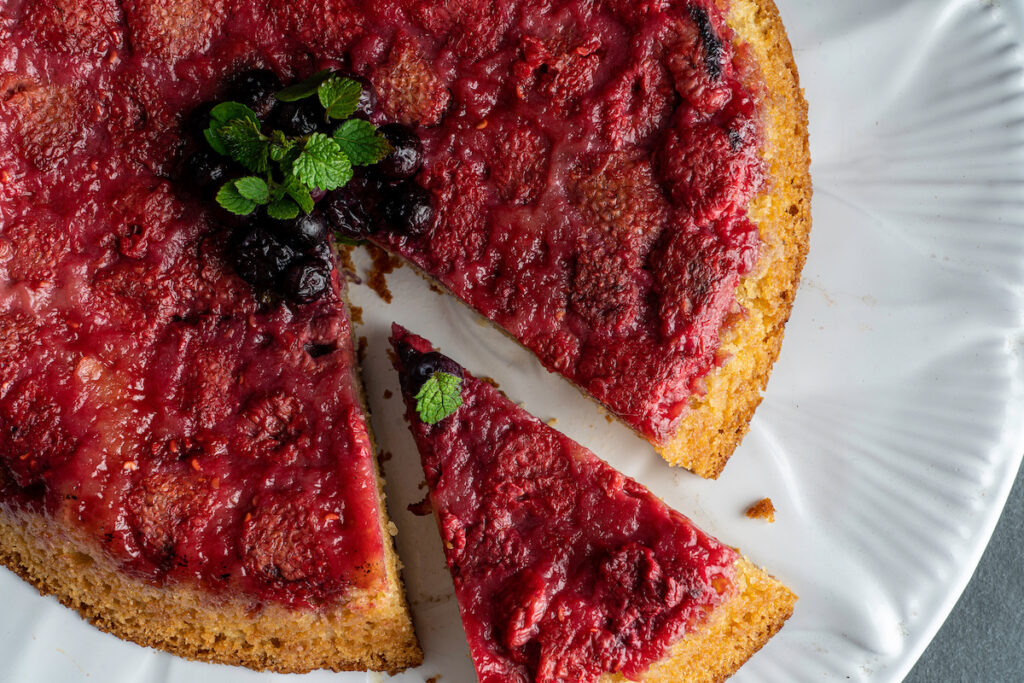
Peach Upside Down Cake
Summertime calls for a refreshing Peach Upside Down Cake. Start with a layer of fresh or canned peach slices, a sprinkle of brown sugar, and a hint of cinnamon. A light, white cake batter tops the peaches, and when baked and inverted, you’ll enjoy a gorgeous, golden peach-topped cake.
Banana Upside Down Cake
For a tropical twist, I suggest a Banana Upside Down Cake. Layer the bottom of the pan with sliced bananas, caramelized with brown sugar and butter. Add in a rich cake batter flavored with cinnamon and a touch of rum for the perfect balance of flavors.
Cherry Upside Down Cake
A Cherry Upside Down Cake is ideal for those who adore the tangy-sweet taste of cherries. Simply coat the bottom of the pan with a layer of pitted cherries and sugar, then add your favorite vanilla or almond-flavored cake batter. When baked and inverted, this cake will display a beautiful red cherry pattern.
Pear Ginger Upside Down Cake
For a sophisticated combination of flavors, try a Pear Ginger Upside Down Cake. Start with a layer of sliced pears, melted butter, and brown sugar at the bottom of the pan. The ginger-infused cake batter creates a stunning and fragrant dessert that your guests will adore.
Mango Upside Down Cake
Refreshing and fruity, a Mango Upside Down Cake offers a brilliant burst of color and flavor. Start by layering fresh mango slices at the bottom of the pan, then top with a delicate white or yellow cake batter. Enjoy this tropical delight as a unique alternative to the traditional pineapple version.
Lemon Blueberry Upside Down Cake
A bright and zesty Lemon Blueberry Upside Down Cake is perfect for incorporating a citrus kick. Line the bottom of the pan with a layer of plump blueberries, then add a lemon-infused cake batter. The vibrant colors and flavors will make this a popular choice for spring gatherings.
Caramel Nut Upside Down Cake
For a rich and indulgent wintertime dessert, consider a Caramel Nut Upside Down Cake. Begin with a layer of your favorite nuts, such as pecans or walnuts, and drizzle with caramel sauce. A dense, buttery cake batter provides the perfect foundation, and when inverted, you’ll reveal a beautifully caramelized nut topping.
Armed with these helpful tips and variations, I have no doubt you will create some of the most delicious and beautiful upside-down cakes imaginable. Happy baking!
